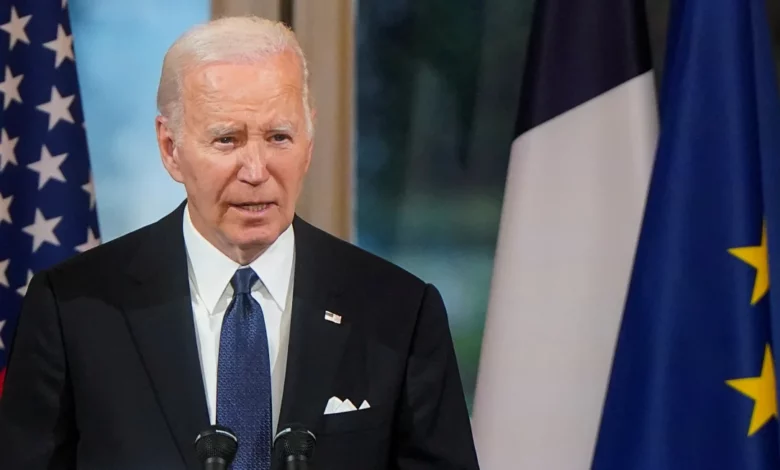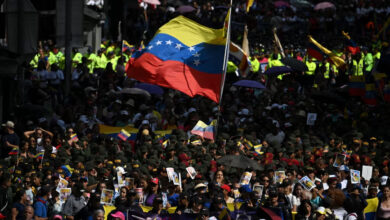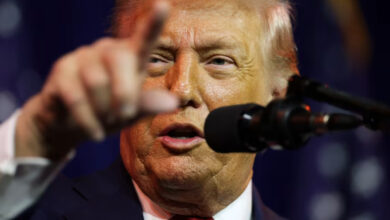
President Joe Biden is leading the world’s richest democracies in sending a beefed-up message to Russian President Vladimir Putin that the West will not forsake Ukraine despite political shocks casting doubts over its commitment.
Biden meets Ukrainian President Volodymyr Zelensky in Italy on the sidelines of the G7 summit Thursday, aiming to personally reinforce a promise he spelled out last week on Normandy battlefields where fascism began to crack 80 years ago.
“We will not walk away, because if we do, Ukraine will be subjugated and it will not end there,” Biden said surrounded by the last surviving US veterans of D-Day and the graves of more than 9,000 of their fallen comrades. “Ukraine’s neighbors will be threatened. All of Europe will be threatened. … The autocrats of the world are watching closely to see what happens in Ukraine.”
Yet Biden’s undertaking will come up against growing concerns in Europe that he will merely be an interregnum between two Donald Trump administrations. The ex-president’s term that ended in 2021 shattered decades-old certainties that the United States will be a stabilizing force in transatlantic affairs and will always secure Europe’s security. And the “autocrats of the world” name checked by Biden will no doubt be watching on Thursday when Trump demonstrates his lock on the Republican Party by meeting GOP House members and senators on Capitol Hill. The show of authority will take place two weeks after Trump became the first former president to be convicted of a crime and less than five months before the presumptive Republican nominee will ask voters to return him to the White House.
Biden’s emotional, political and diplomatic investment in Ukraine cannot be questioned and will be the foundation of his presidential legacy. But uncertainty over the West’s long-term commitment is perennially stubborn. It’s fueled by shifting political currents on both sides of the Atlantic that must worry Zelensky.
In the United States, Trump – who disdains Ukraine, lionizes Putin and cares little for Europe’s security given his endless attacks on NATO – may be less than five months from winning back the presidency. Big gains by far-right parties in European Parliament elections last weekend – especially in powerhouses France and Germany – could create future complications for European Union support for Ukraine. And Putin’s willingness to throw thousands of Russian lives into the meat grinder of the front-line without suffering any political effects back home in a nation purged of political opponents means the possibility always remains that the West tire of the conflict before he does.
But a flurry of new initiatives from the US and its allies looks like an attempt to Trump-proof Ukraine’s Western lifeline and to bring Kyiv closer to Western economic and defense structures should Biden and wobbling G7 leaders who formed the first wave of its support after the Russian invasion get swept away. But no US president can truly bind his successor to a course of action. And the tortuous delays in squeezing the latest $60 billion US aid package for Kyiv through Congress underscore that America’s fractious politics means that future US largesse cannot be guaranteed even if Biden wins in November.
A flurry of new Western plans to help Ukraine
Still, the latest Western plans to help Ukraine send a strong message of intent.
—Biden’s return to Europe Wednesday, only three days after he left, encapsulated his role as the most proactive leader of the Western alliance since President George H.W. Bush. Time on the presidential calendar is a reliable barometer of a White House’s priorities and is closely watched by both US allies and adversaries.
—As he left for Italy, the administration unveiled new sanctions on more than 300 individuals and entities designed to paralyze the parallel economy, which includes plentiful Chinese channels, that the Kremlin has constructed to evade previous US punishments. The sanctions target foreign financial firms aiding Putin’s war effort, restrict Russian access to some US software and information technology. “Russia today has become a war economy,” Treasury Secretary Janet Yellen said, unveiling measures designed to raise the cost of that conflict. “Every day, Russia continues to mortgage its future to sustain its unjust war of choice against Ukraine.”
—Biden and Zelensky are expected to sign a bilateral security pact that commits the US to train Ukraine’s armed forces for 10 years and to expand cooperation in the production of armaments and equipment. “We want to demonstrate that the US supports the people of Ukraine, that we stand with them and that we’ll continue to address their security needs not just tomorrow but out into the future,” Jake Sullivan, Biden’s national security adviser, told reporters on Air Force One. Still, the “executive agreement” would not be hard for Trump to break if he wins power.
—US officials are also optimistic that the G7 summit – which groups the US, France, Britain, Germany, Japan, Italy and Canada – will sign off on months of negotiations on a $50 billion economic support package to finance the repair of Ukrainian infrastructure to be financed by the interest on frozen Russian assets.
—These measures are expected to be bolstered by a new NATO package to be unveiled at the alliance summit in Washington later this summer that would institutionalize military support for Ukraine. The move would still however fall well short of Zelensky’s elusive wish for a clear timetable for entry into the Western alliance.
Russian advances on the battlefield
These are substantial and credible political, economic and political demonstrations of support for Ukraine. But they come at a vulnerable time for the country with its survival far from assured.
The latest battlefield assessment released by the Hudson Institute, for instance, cites “a worrisome trend” of incremental gains on multiple battlefronts, including in eastern and northeastern Ukraine.
Relentless Russian attacks on civilian infrastructure have destroyed half of Kyiv’s electricity production capacity, the report found, underscoring why already, in mid-June, there are mounting concerns about the plight of Ukrainian civilians in the coming winter with Russia expected to double down on past efforts to use the annual chill as a weapon.
Russian success in rebuilding a military machine that was shockingly devastated on the road to Kyiv two years ago has led some senior European officials to warn of a mounting threat to Europe’s territorial integrity. Wider tensions between the US and Russia are meanwhile being highlighted by the arrival of a convoy of Russian ships in Cuba that has Cold War overtones.
Retired Gen. Wesley Clark, the former supreme allied commander of Europe, warned in a Hudson Institute briefing this month that it would be wrong to underestimate the potency of the Russian military following the mockery in the West that greeted the decimation of the Kremlin expeditionary force and its poor leadership and tactics earlier in the war.
“The Russian character, the Russian force is structured around grinding forward, grinding forward regardless of losses, grinding forward through bad command decisions,” Clark said. “Don’t underestimate them. Technically, they’re pretty smart. They’ve got China behind them; they’ve got Iran and sanctions-busting behind them.”
Ukraine’s heroic resistance to the Russian invasion in early 2022 was an inspirational moment. But the blue and yellow flags that once seemed to be flying everywhere in Western cities have become ragged and faded more than two years later.
An inspiring war turns into a bitter slog
An extraordinary moment of instability in developed-world politics has forced many foreign leaders to prioritize their own problems, even while seeking to sustain support for Kyiv. A new war following the Hamas terror attacks on Israel shifted attention away from the conflict in Ukraine – which simultaneously evokes the carnage of the trench warfare of World War I and a frightening new era of warfare with swarming drones delivering death to troops in their fox holes.
At times, an annoyed tone has crept into some of the exhausted Zelensky’s interactions with the West.
The Ukrainian leader made no secret of his frustration at the time it took to deliver the latest US aid package – a delay for which Biden apologized when he met with Zelensky at the D-Day event. He has also expressed impatience that world leaders have not taken up his invitation to a summit in Switzerland after the G7 designed to unite the world behind his vision of how an eventual peace deal to end the war could shape up.
Biden, who is taking repeated days off from the campaign trail to travel to Europe, will not attend. Vice President Kamala Harris will be there instead, alongside Sullivan.
Not surprisingly, Zelensky has always chafed at the self-imposed limits of Western support for his war effort that are a symptom of Biden’s core aim of avoiding a direct NATO confrontation with Russia. The US president’s critics have long accused him of only offering Kyiv the means to avoid losing the war but declining to provide the wherewithal to win it. Biden has, however, recently allowed the use of limited categories of US weapons in limited circumstances in Ukrainian operations on Russian soil.
John Kirby, the White House National Security Council spokesman, insists that Biden is determined to “take bold steps to show Mr. Putin that time is not on its side and that he cannot outlast us, as we support Ukraine’s fight for freedom.”
But there’s a rising tide of political tension, high stakes elections and ideological estrangement between globalists and isolationists in Western societies and a Russian leader who ruthlessly refuses to change course whatever the cost. So however long the war lasts, the West will never escape questions about its staying power.




